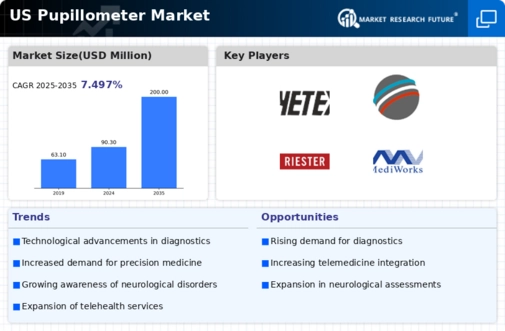The US Pupillometer Market is characterized by significant competition, driven by the increasing focus on accurate diagnostic tools in ophthalmology and neurology. As healthcare professionals increasingly recognize the importance of pupillary response evaluation in various clinical settings, the demand for advanced pupillometers has surged. This market encompasses a range of manufacturers and suppliers, each innovating to capture a share of the growing demand for these devices. Competitive insights highlight not only the product offerings and technological advancements but also the strategic partnerships, marketing approaches, and customer engagement tactics employed by the key players in this space.
Understanding the competitive landscape is essential for both new entrants and established companies aiming to enhance their market positioning.
Eyetex has established a notable presence in the US Pupillometer Market, recognized for its commitment to quality and innovation in pupillometry technology. The company's offerings are characterized by their accuracy, user-friendly interfaces, and a robust support infrastructure, which are significant strengths that resonate well with healthcare practitioners. Eyetex has focused on building strong relationships with eye care specialists and educational institutions, facilitating an environment conducive to product demonstrations and training. This engagement strategy not only enhances customer loyalty but also aids in the sustained growth of the brand.
Their reputation for reliability ensures that Eyetex remains competitive, responding adeptly to the evolving needs of clinicians while maintaining high standards in their product line.
MarCo Manufacturing stands out in the US Pupillometer Market through its expansive portfolio of diagnostic equipment catering specifically to the needs of ophthalmic practices. The company emphasizes the development of integrated solutions that align with the latest advancements in medical technology. MarCo Manufacturing's strengths lie in its innovative design and manufacturing processes, which prioritize both functionality and ease of use for clinicians. The company has made strategic moves, including partnerships and potential mergers aimed at enhancing their product offerings and market reach. By focusing on high-quality pupillometers alongside complementary diagnostic tools, MarCo Manufacturing effectively expands its market presence.
Their commitment to research and development ensures that they remain at the forefront of technological advancements, thereby solidifying their position within the competitive landscape of the US Pupillometer Market.














